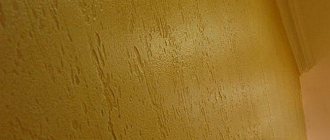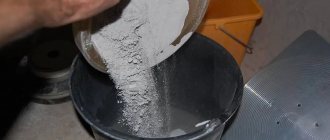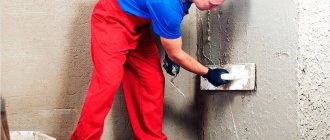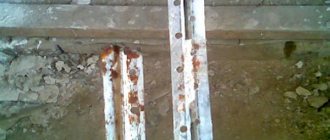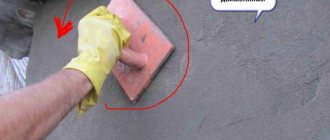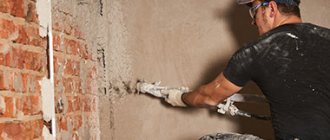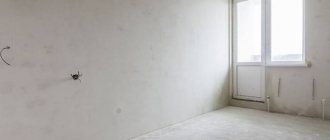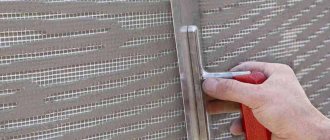Not all sand is suitable for plaster, and there are even regulatory rules for construction sand raw materials. Do not rush, beginners, to take the first sand you come across as a “filling” for the plaster mortar. We advise you to learn about the types of sand, how different types of sand affect the characteristics of the plaster solution and the final result of finishing work.
Selecting sand for the desired type of plaster
Sand is different from sand, both in origin and in properties. When this is understood, the question arises about what the properties of the sand filler of the plaster mortar influence, and what kind of sand should be used for plastering. Sand raw materials are formed during the process of rock erosion and are a mixture of grains of various shapes and sizes (from dust to small pebbles up to 5 mm in size).
In the composition of mortars, sand grains act as a small-sized frame, ensuring the strength of the plaster solution and reducing its cost. The grains of sand, while remaining chemically inert, are bonded to each other by crystals of binders formed during the chemical reaction. The strength of these bonds, and therefore of the entire artificial stone (hardened mortar), depends on the roughness and shape of the grains. The volume of sand filler (in the solution) determines how much more or less of the binder component is required.
First, we note that sand material can be natural and artificial.
Natural sand deposits are of different origins:
- marine;
- quarry (or gully);
- river
Characteristics such as the shape of sand grains and the content of foreign inclusions depend on how these deposits were formed. Foreign inclusions may not be as inert as grains of sand.
mica impurities
For example, the following are considered undesirable impurities:
- organic substances (reacting with cement, destroying it);
- sulfur compounds (by participating in reactions, they cause metal corrosion and cement decomposition);
- mica particles (fragile, easily weathered, poorly adhered to the base of the solution);
- dusty and silty particles, clay formations (having dimensions less than 0.15 mm, envelop sand grains and prevent the adhesion of binder crystals to them).
GOST standardizes the upper limit of the content of these particles and methods for determining their quantity in sandy raw materials.
If the content of organic matter and sulfur can be determined by laboratory methods, then the presence of silt and clay is determined by rubbing a handful of wet sand in the palms. Clean sand grains do not stain your palms.
An important characteristic is the granulometric composition - the percentage of grains of different sizes.
Based on grain size, sand raw materials are divided into fractions:
- large (grains from 2 to 4 mm);
- medium (particle sizes from 0.5 to 2 mm);
- small (particles within 0.25 to 0.5 mm).
Also, for decorative compositions, the sand material can be of a very fine fraction (up to 0.25 mm).
The shade depends on the rocks from which the sand raw material was formed.
The color of the bulk product may also indicate the presence of certain minerals:
- reddish and orange shades are inherent in metal oxides;
- shades of greenish or bluish tint - river sands with aluminum salts;
- Quartz grains are distinguished by their white color.
Quartz sand is a rather rare material, so it is more expensive. Used for primers, for example, concrete contact, some types of plasters.
What are the benefits of using river sand for plaster?
To answer the question, you will have to understand the characteristics of the river filler. Before settling in the river bed, grains of sand and larger stone fragments formed during the weathering of stone travel a long way. When attracted by water currents, the grains roll around and become round. This feature of the shape of the grains affects the (plasticity) workability of the plaster mixture, because rounded grains of sand do not cling to each other with sharp protrusions.
river sand mining
The second feature, the reason for which is the rounded shape, is the non-shrinkability of the plaster mixture. When applying the solution, the rounded grains immediately pack tightly and, forming a skeleton, practically do not allow the plaster coating to settle when drying and hardening. Mortars with river filler are non-shrinkable (the amount of shrinkage is very small), therefore the thickness of the freshly laid layer and the hardened layer are the same.
This property is welcome for the manufacture of concrete screeds, foundations, and mixing masonry mortars.
The flip side of non-shrinkage is an increase in the volume of required binder. The gaps between rounded grains are larger than between angular grains, and they cannot be reduced by compacting or vibrating.
River sand most often has larger granules than quarry sand.
A lower content of clay or silty particles is an advantage of this type of raw material. In addition to the need for more binder, the disadvantage is that the cost of such sand for plastering walls is higher (due to the technological features of extraction, for example, the use of hydraulic alluvium). Plaster mortar with river filler adheres worse to unprepared substrates.
River filler is used in decorative compositions, for example, for bark beetle plaster. It is preferable for the covering layer (and generally for upper plaster layers). The fine fraction of river sand can be used to prepare putty yourself (by mixing it with acrylic water-based paint or glue).
Using quarry sand
Gully sand is usually finer. The quarry material has angular grains, which gives the solution the property of shrinkage. When vibration occurs, the granules can shift, then the smaller ones move into the spaces between the larger ones. A similar picture arises during the setting process, when the emerging crystalline bonds pull neighboring filler particles together. For 1 cm of layer height, shrinkage can be 1 mm.
This behavior of the solution is acceptable for spray and soil during rough leveling. But if, when leveling using beacons, a layer of 5-6 mm is applied on one section of the wall, and 3 cm on another, then after the solution hardens, the surface will not be smooth.
For processing facades or finishing utility rooms, quarry sand is preferable for plaster.
Gully material is cheaper, more common, and mined at a lower cost. It contains more clay particles and may contain mica and sulfur compounds. Therefore, it is better to purchase such a filler from a reliable manufacturer.
In a mixed plaster mortar, sand grains of gully origin settle faster than rounded river grains, so it is recommended to stir the mortar with quarry sand filler more often to maintain the homogeneity of the mass.
If the quality of quarry raw materials is unknown, a portion of the material is filled with water with the addition of alkali (a small amount). If the sand mass darkens, it is washed at least three times. It is also necessary to sift to remove large and foreign inclusions.
Sometimes it is possible to level out the characteristics of a quarry filler by adding river filler to it.
Sea sand
Sea sand is natural, mined in Russia in the Gulf of Finland and Crimea. The sand material lying at the bottom is contaminated with various organic as well as inorganic impurities (clay), so it is subjected to purification. Due to expensive cleaning and the relatively small amount of material entering the market, this sand is more expensive than other types. It has better qualities in comparison with river sand, its use allows reducing cement consumption, which is why sea sand is readily used by manufacturers in decorative plasters.
sea sand mining
Special types of sand for plasters
In addition to natural sand, artificial sand filler is used in construction. It is obtained from waste from crushing rocks. The stone is ground, the resulting material is washed and fractionated, resulting in angular grains. This type of filler can cause significant shrinkage.
Artificial grain material is sometimes treated with powdered dry adhesives to increase adhesion. To increase the surface area and roughness required for plaster compositions, the grains are thermally hardened. All this affects the cost.
perlite sand
There are also special types of filler:
- barite (for X-ray protective plaster), the substance is poisonous (!);
- perlite (for heat-insulating plaster).
Quarry and river sand
The choice of filler depends on the thickness of the layer to be applied.
For finishing work with a thin layer, it is best to use river sand. Compared to other types of this material, it is environmentally friendly. It is extracted from the river bottom by a dredge. This sand aggregate contains no clay grains and virtually no stones. With an average size of up to 2.2 mm, it does not shrink, which makes it possible to use it for plastering walls and masonry.
If rough finishing of the walls with a thick layer is intended, then material of river origin is not recommended. As a result of many years of exposure to water, the sharp edges on the grains of sand have been erased. And therefore it consists of small smooth balls that do not adhere well to the base and to each other.
Quarry sand can provide a stronger coating with good adhesion. This ensures a long service life of the finish. It owes its origin to weathering. Quarry sand is formed from quartz rocks, mica and feldspar. It is mined by open-pit mining from rocks. The cost of such filler is significantly lower than river filler. When purchasing plastering material, be sure to check whether it has been washed or cleaned.
Which version of sand is suitable for plaster?
Beginners need to know: which sand is best to use for plastering walls?
Plaster compositions differ from concrete ones, because the plaster material must simultaneously fulfill the following conditions:
- the plaster layer must be vapor-permeable, for which there must be air pores in it;
- the solution must create a coating of sufficient strength and at the same time have minimal shrinkage;
- the composition must be both plastic and viscous (so as not to flow off the walls during installation) at the same time.
These qualities are regulated during mixing by adding modifying additives, lime and sand. It would be correct to use the most suitable version of sand raw materials for each of the plaster layers.
For example, for:
- for layers of spray and soil, it is better to use raw materials mined in a quarry;
- decorative compositions, covering or top layer of soil (when plastering walls without covering) - river filler.
Cement mortar
The most popular binder is cement. In cement plasters, a cheaper filler is usually used, however, the use of both river and quarry material is allowed.
cement-sand mortar
The gully filler must be pre-cleaned:
- sift through a mesh with a mesh size of 4-5 mm, removing large debris in advance;
- soak and stir periodically to disperse the lumps of clay (4-5 hours);
- drain the contaminated water and replace it with clean water;
- Stir the mixture vigorously and pour the upper part of the contents of the container into a second container;
- After settling, drain the water and dry the sand.
Lime mixture
The lime itself, disintegrating during slaking, forms tiny particles, due to which the lime mortar has high plasticity. Therefore, even angular quarry sand fits well when applying lime mortar. It is most often used for fatty lime. For lean lime dough, river material is used as a filler.
Clay mortar
Both types of sand material are used as a filler for clay plaster. If the clay is thin, then the kneading is done using unwashed river raw materials. For fatty clays with high plasticity, quarry filler is used. Proportions are selected by mixing samples.
clay mortar
What kind of filler is needed in clay plaster?
When faced with the problem of choosing which sand to use for plastering walls inside a house, it is appropriate to consider the option of a clay mixture. It is environmentally friendly, suitable for allergy sufferers and will last for many years. If the layer is thin, it is better to use river sand; for a thick plastic layer, washed quarry material is used.
The clay mixture is applied in the same way as the cement mixture. At the very end, when the finishing layer is applied, you will need lime paste. Its addition will fix the surface and make it more suitable for a decorative layer.
How to sift sand correctly
To sift large quantities of sandy raw materials, metal woven meshes with a mesh size of up to 5 mm are used (usually for cement mortars a filler with 2-4 mm granules is used). The mesh can be mounted on a wooden frame with sides. If the volume of sand mixture is small, then you can stretch either a mosquito net or tulle. Dry material is taken for sifting.
separation of large impurities from sand
sifting sand through a sieve
If sandy raw material is contaminated with clay inclusions, it is washed and dried before sifting.
Sifting is usually done outside. You should choose a dry, not very windy day. The air flow will blow out light dust particles of unwashed material, and place small grains of sand away from large ones on the leeward side.
There are also special installations for sifting sand, but you should not purchase them for one-time work.
Types of filler for cement-sand mortar
Sand aggregate is divided into types according to the size of grain fractions:
- coarse-grained with grain size from 2 to 4 mm;
- medium fraction with grain size from 0.5 to 2 mm;
- fine-grained with grain size from 0.25 to 0.5 mm.
To plaster walls with your own hands with a cement-sand mortar, medium-fraction sand is usually used. It must be of high quality, without impurities. How uniformly and smoothly the layer will lie depends on the size of the sand grains. The smaller they are, the easier it will be for you to work with the solution. It is perfect for finishing leveling floors or walls. For the first (rough) layer of plaster, coarse sand is used. To prepare the plaster mortar, it is worth purchasing already cleaned and sifted sand.
It is important to know that even with high roughness, the finer it is, the greater the amount of binders and water needed to envelop it.
GOST standards
The main characteristics that sand for plaster must have are specified in two standards - GOST 8736-2014 and GOST 28013-98. According to them, granular filler is divided into two classes:
- Class I – coarse sand materials;
- Class II - fine-grained fillers, which additionally have smaller fractions, for example, very fine (with grains less than 0.16 mm).
For each class, the maximum permissible content of harmful impurities or components, dust particles is prescribed.
Composition and features of the plaster mixture
Any plaster mixture includes two components: a binder and a filler. The first is gypsum, cement, lime or combinations thereof. The second is sand, stone chips or slag. Sometimes various additives are additionally added to the mixture to improve certain properties. For example, setting time or adhesion.
Each of the components of the solution performs its task. Thus, the plaster’s tendency to crack, strength, ductility, adhesion, water resistance and hardening speed depend on the binder. In turn, the filler affects the appearance of the plaster layer, sound and heat insulation properties, and strength.
Plaster composition
Any plaster solution includes several components. According to their purpose, components are divided into binders (forming a binder base), fillers (inert substances that do not react chemically), and modifying additives.
Binder
Among binding materials, cements are the most common. For plastering purposes, Portland cement is usually used (for special plasters, cements of other types can be used). For interiors, gypsum is used as a binder, less often lime, and sometimes clay. These are classic mineral binders that can be used either alone or in combination, for example, cement-lime compositions. Modern materials used for the base are polymers.
Depends on the type of binder:
- strength of the plaster coating;
- adhesion (tenacity);
- durability;
- setting time;
- water resistance;
- plasticity (for example, the addition of lime increases workability) and other characteristics.
Filler
The main purpose of filler has long been to reduce the amount of more expensive binder. For plastering purposes, sand has long been the main filler. Its quantity in the solution is determined in parts of the quantity (volume or weight) of the main binder. In addition to sand filler, plasters may contain slag, artificial granules and fibers of various origins.
The quality of the plaster coating also depends on the quality of the filler. Therefore, special requirements are put forward to the type and quality of sand.
We also recommend a useful video on the topic of the article.
For plastering work, you can use any of the sands. But each type of sand material has features that need to be taken into account. By correctly choosing the right sand for plastering, according to its characteristics, you will avoid surprises in the work and get a good quality plaster coating.
Which one is better to use for plaster?
Your choice of sand for plaster
Riverquarry
The choice depends on the type of work performed. Do not forget about the thickness of the proposed plaster. If you need to make a coating of 3-4 mm, then, naturally, you should mix fine-grained aggregate, otherwise, vice versa.
Quarry sand is better suited for soil and spray, as it has more sharp edges and adheres better to the wall surface. The decorative finishing layer is usually made of artificial or river material.
What kind of sand you don’t need to buy at all is very fine, dusty sand. It gives extremely weak adhesion; it is impossible to prepare a high-quality solution with it.
Decorative plaster
Decorative plaster with sand is a type of interior decoration. When making decorative plaster, river or quartz sand is used, as well as reflective components and additives that determine color. Depending on the type of surface, types of plaster are divided into matte and pearlescent.
This type of wall decoration is environmentally friendly; when using additional components, it is resistant to moisture, mold, and resistant to destruction during operation.
Plastering sand, which is part of decorative plaster, is used to create patterns on the surface of walls: sand whirlwinds, dunes, special visual effects that are created using stencils and brushes.
Photo of decorative sand finishing:
Recommendations for the selection of sand mixtures for plaster
Despite the fact that the process of preparing a plaster mixture for walls is in many ways similar to mixing concrete, there are quite serious differences. Plastering walls requires that several conditions be met at once:
- The mass should have minimal shrinkage with a sufficiently high surface strength;
- The plaster layer must contain a certain number of air pores to ensure vapor permeability of the walls;
- The plaster material must be viscous so as not to drain from the surface of the walls, and at the same time plastic to ensure leveling of the plane.
All of the above qualities are best regulated by adding sand, lime and polymer additives. In addition, proper execution of plaster involves applying several layers to the wall, even if the thickness of the finishing material is relatively small. Ideally, in order to achieve good wall permeability and at the same time high strength of the plaster material, you will need to select your own version of sand for each layer of plaster.
Features of quarry sand
This type of sand is mined using a quarry method. Moreover, material from different deposits can differ significantly in grain size, composition and structure. The amount of clay impurities in quarry sand reaches 7%. In addition, it may contain silicon salts and metal oxides. Its grains have sharp edges and the particle size ratio is very different.
Loading quarry sand
Applying plaster with sand
The application of plaster containing sand has a number of features. First you need to do:
- thorough surface preparation - cleaning from stains and dirt;
- leveling walls;
- two coats of primer.
The pattern on the surface is leveled using a spatula. After the surface has completely dried, wax and special toners are applied on top.
When decorating walls, the manufacturer's instructions determine the specifics of using decorative plaster: in one case, the composition is mixed to evenly distribute the fillers, in another, dilution with water is required.
Selecting the type of sand for the plaster mixture
Quarry and river sand impart different properties to the plaster mixture. Thus, the grains of the first have a rough surface and sharp edges, therefore they contribute to better adhesion to a concrete or brick surface. It increases the strength and durability of the coating, but at the same time helps to increase the rigidity of the solution. When its proportion in the mixture increases, cracks may form. The use of such material is optimal for preparing the first (rough) layer of plaster.
River sand has its own specific characteristics. Its grains have a rounded and smooth shape, so a solution based on this material adheres much worse to an unprepared surface. It is used to form a finishing coating of small thickness. The density of such plaster is lower than that of a mixture based on quarry sand. In addition, it has better ductility and is easy to apply to a previously prepared surface. Increasing the proportion of sand in the mixture does not lead to the formation of cracks. After drying, the plaster allows water vapor and air to pass through well and has high heat and sound insulation properties.
